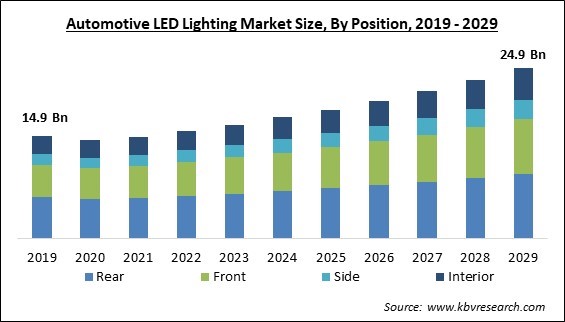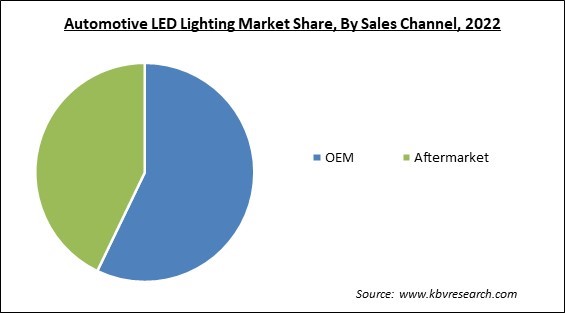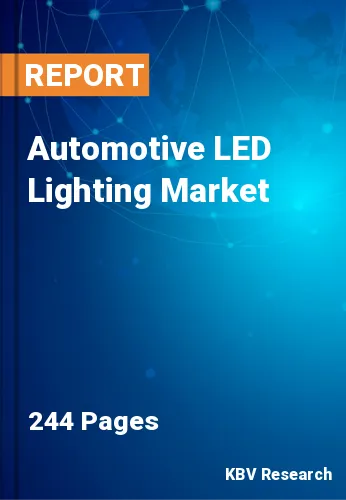The Global Automotive LED Lighting Market size is expected to reach $24.9 billion by 2029, rising at a market growth of 6.9% CAGR during the forecast period.
Lighting is essential in automotive because it illuminates the vehicle's route and gives the driver a clear view of the road. The lighting system not only provides the necessary lighting for the driver's path but also aids other motorists and pedestrians in recognizing the vehicle's size, location, and motion. In addition to giving the inside and external portions of the car a visual boost, it also makes the car more noticeable. Devices for lighting and signaling are included in the lighting system.

LED lighting technology has become widely accepted in modern times. DRLs, which have now become standard on several automobiles, use LEDs as their primary component. These lights are typically fitted in high-end automobiles like the Audi A7 and the BMW X7, but due to developments in technology and falling costs, they are now widely used in affordable cars as well. Around the world, several nations are implementing laws to encourage fuel-efficient vehicles and limit the dangerous CO2 emissions they produce.
According to regulations by the European Commission, automakers must implement effective steps to lower CO2 emissions from their vehicles. As a result of LED lighting's excellent power efficiency and low CO2 emissions, auto manufacturers are moving toward more environmentally friendly LED lighting technology. As a result, these lights are being used in many different places, including headlights, parking lights, DRL, turning lights, and brake lights. Furthermore, the automotive LED lighting market is expected to develop faster than average during the forecast period due to factors like the rising emphasis on road safety, rising demand for innovative automotive technology, and rising adoption of electronic systems in vehicles.
The COVID-19 outbreak compelled governments worldwide to implement stringent lockdowns and prohibit importing and exporting essential raw materials for most of 2020 and a few months of 2021. This resulted in an abrupt decrease in the availability of vital raw materials for vehicle components, which had a negative effect on the market for automotive LED lighting. As a result of lockdowns and restrictions, consumer preferences have shifted, resulting in a global decline in automobile sales and a decline in automobile utilization. In addition, after a certain period of their operating life cycle, automotive LED lighting must be replaced, and travel restrictions have affected demand for replacements of automotive LED lighting.
Due to the rise in traffic accidents worldwide, there is a greater demand for safety elements and adaptive lighting systems. Advanced and adaptive vehicle lighting allows the driver to take the necessary measures by detecting objects on the road. Globally increasing concern over traffic accidents drives demand for greater safety features in cars, which eventually results in installing effective lighting systems, further driving the growth of the automotive LED lighting market.
The demand for vehicles with cutting-edge technology has increased as global vehicle production and sales have risen. This has motivated the makers of vehicles to create and include cutting-edge components in the following vehicle models. In addition, many innovative technologies, including the adaptive front-lighting system (AFS) and the Adaptive Driving Beam (ADB), are being added by automakers to their vehicles to increase comfort and convenience.
The market for automotive LED lighting is concerned about the high cost of LED lights. Currently, projector headlights-which are more expensive than reflector headlights and take up more room within the vehicle-are utilized with LED bulbs. On the other hand, halogen, xenon, and LED lights are frequently utilized lighting technologies in high-end or premium automobiles because of their advantages, such as decreased power usage, cooler temperatures, and extended self-life of LED lights.
By position, the automotive LED lighting market is segmented into front, rear, side, and interior. The front segment projected a prominent revenue share in the automotive LED lighting market in 2022. An essential component of safety, energy efficiency, dependability, and user experience for emotional identification, LED front lighting is a major differentiator for auto manufacturers. The main purpose of a car's headlights is to illuminate the road, making it easier to drive safely and without getting tired.

Based on sales channel, the automotive LED lighting market is fragmented into OEM, and aftermarket. The aftermarket segment acquired a substantial revenue share in the automotive LED lighting market in 2022. The aftermarket provider replaces outdated lighting in pre-owned vehicles or repairs a damaged light on a vehicle. Automotive LED lighting is growing increasingly popular in the aftermarket due to customers' desire to enhance their vehicles with cutting-edge parts to increase driving safety.
On the basis of vehicle type, the automotive LED lighting market is categorized into passenger car and commercial vehicle. In 2022, the passenger car segment held the highest revenue share in the automotive LED lighting market. The penetration of advanced lighting in passenger vehicles relative to other vehicles, notably buses, trucks, and light commercial vehicles (LCVs), is the main reason fueling the segment's rise. Demand for passenger cars is also projected to increase due to rising passenger vehicle sales and consumers' willingness to pay more for cars.
By propulsion type, the automotive LED lighting market is bifurcated into ICE, electric, and others. In 2022, the ICE segment witnessed the largest revenue share in the automotive LED lighting market. One of the main factors influencing the segment's growth is the rising demand for high-end and luxury vehicles as well as the advancements in adaptive lighting technology. As LED lights use less electricity and have a longer lifespan, vehicle manufacturers are showing a lot of interest in incorporating them into their vehicles, which is assisting the expansion.
| Report Attribute | Details |
|---|---|
| Market size value in 2022 | USD 15.7 Billion |
| Market size forecast in 2029 | USD 24.9 Billion |
| Base Year | 2022 |
| Historical Period | 2019 to 2021 |
| Forecast Period | 2023 to 2029 |
| Revenue Growth Rate | CAGR of 6.9% from 2023 to 2029 |
| Number of Pages | 244 |
| Number of Table | 430 |
| Report coverage | Market Trends, Revenue Estimation and Forecast, Segmentation Analysis, Regional and Country Breakdown, Companies Strategic Developments, Company Profiling |
| Segments covered | Position, Sales Channel, Vehicle Type, Propulsion Type, Region |
| Country scope | US, Canada, Mexico, Germany, UK, France, Russia, Spain, Italy, China, Japan, India, South Korea, Singapore, Malaysia, Brazil, Argentina, UAE, Saudi Arabia, South Africa, Nigeria |
| Growth Drivers |
|
| Restraints |
|
Region wise, the automotive LED lighting market is analyzed across North America, Europe, Asia Pacific, and LAMEA. In 2022, the Asia Pacific region led the automotive LED lighting market by generating the highest revenue share. Asia Pacific is anticipated to be the world's largest market for automotive lighting due to rapid customer acceptance and strong automobile sales. China and Japan are important players in this region because of their high domestic automobile manufacturing and sales.
Free Valuable Insights: Global Automotive LED Lighting Market size to reach USD 24.9 Billion by 2029
The market research report covers the analysis of key stakeholders of the market. Key companies profiled in the report include NXP Semiconductors N.V., Robert Bosch GmbH, Valeo SA, OSRAM GmbH (AMS AG), Grupo Antolin-Irausa, S.A., HELLA GmbH & Co. KGaA, Aptiv PLC, Denso Corporation, Hyundai Mobis Co., Ltd., and Koninklijke Philips N.V.
By Position
By Sales Channel
By Vehicle Type
By Propulsion Type
By Geography
The Market size is projected to reach USD 24.9 billion by 2029.
Growing Demand for Advanced Technologies in Vehicles are driving the market in coming years, however, LED Lights are Expensive restraints the growth of the market.
NXP Semiconductors N.V., Robert Bosch GmbH, Valeo SA, OSRAM GmbH (AMS AG), Grupo Antolin-Irausa, S.A., HELLA GmbH & Co. KGaA, Aptiv PLC, Denso Corporation, Hyundai Mobis Co., Ltd., and Koninklijke Philips N.V.
The OEM market acquires highest revenue share in Global Automotive LED Lighting Market by Sales Channel in 2022; thereby, achieving a market value of $13.8 billion by 2029.
The Rear market is leading the Market by Position in 2022; thereby, achieving a market value of $9.4 billion by 2029.
The Asia Pacific market dominated the Market by Region in 2022; thereby, achieving a market value of $9.5 billion by 2029.
Our team of dedicated experts can provide you with attractive expansion opportunities for your business.

